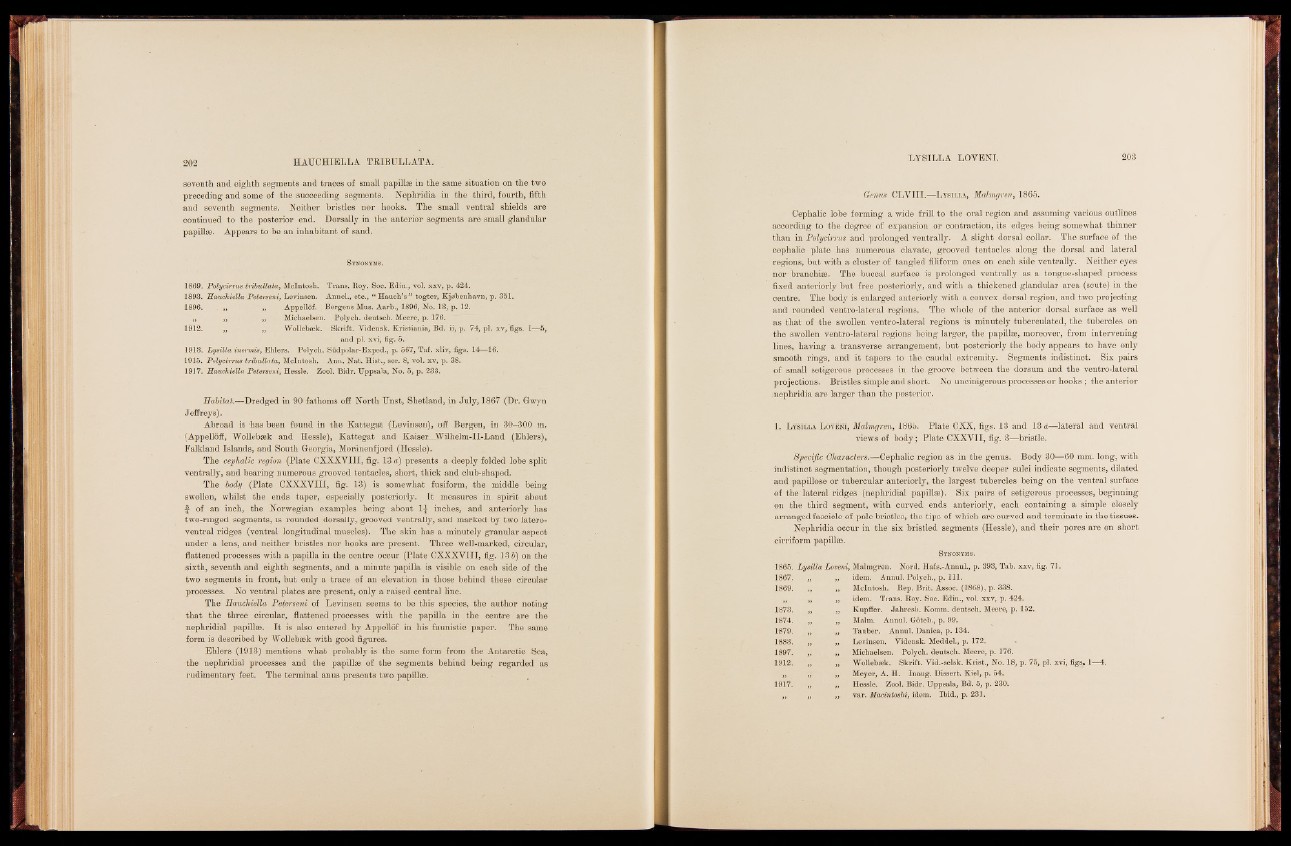
seventh and eighth segments and traces of small papillae in the same situation on the two
preceding and some of the succeeding segments. Nephridia in the third, fourth, fifth
and seventh segments. Neither bristles nor hooks. The small ventral shields are
continued to the posterior end. Dorsally in the anterior segments are small glandular
papillae. Appears to be an inhabitant of sand.
Synonyms.
1869. Polycirrus tribullata, McIntosh. Trans. Roy. Soc. Edin., vol. xxv, p. 424.
1893. Hauchiella Peterseni, Levinsen. Annel., etc., “ Hauch’s ” togter, Kjtfbenhavn, p. 351.
1896. . „ „ Appellöf. Bergens Mus. Aarb., 1896, No. 13, p. 12.
„ ,, „ Michaelsen. Polych. deutsch. Meere, p. 176.
1912. „ ,, Wollebaek. Skrift. Vidensk. Kristiania, Bd. ii, p. 74, pi. xv, figs. 1-—5,
and pi. xvi, fig. 5.
1913. Lysilla inermis, Ehlers. Polych. Siidpolar-Exped., p. 567, Taf. xliv, figs. 14—16.
1915. Polycirrus tHbullata, McIntosh. Ann. Nat. Hist., ser. 8, vol. xv, p. 38.
1917. Hauchiella Peterseni, Hessle. Zool. Bidr. Uppsala, No. 5, p. 233.
Habitat.—Dredged in 90 fathoms off North Unst, Shetland, in July, 1867 (Dr. Gwyn
Jeffreys).
Abroad it has been found in the Kattegat (Levinsen), off Bergen, in 30-300 m.
(Appelloff, Wollebaek and Hessle), Kattegat and Kaiser Wilhelm-II-Land (Ehlers),
Falkland Islands, and South Georgia, Moranenfjord (Hessle).
The cephalic region (Plate CXXXVIII, fig. 13 a) presents a deeply folded lobe split
ventrally, and bearing numerous grooved tentacles, short, thick and club-shaped.
The body (Plate CXXXVIII, fig. 13) is somewhat fusiform, the middle being
swollen, whilst the ends taper, especially posteriorly. It measures in spirit about
f- of an inch, the Norwegian examples being about 1^ inches, and anteriorly has
two-ringed segments, is rounded dorsally, grooved ventrally, and marked by two latero-
ventral ridges (ventral longitudinal muscles). The skin has a minutely granular aspect
under a lens, and neither bristles nor hooks are present. Three well-marked, circular,
flattened processes with a papilla in the centre occur (Plate CXXXVIII, fig. 13 b) on the
sixth, seventh and eighth segments, and a minute papilla is, visible on each side of the
two segments in front, but only a trace of an elevation in those behind these circular
processes. No ventral plates are present, only a raised central line.
The Hauchiella Peterseni of Levinsen seems to be this species, the author noting
that the three circular, flattened processes with the papilla in the centre are the
nephridial papillae. It is also entered by Appellof in his faunistic paper. The same
form is described by Wollebaek with good figures.
Ehlers (1913) mentions what probably is the same form from the Antarctic Sea,
the nephridial processes and the papillae of the segments behind being regarded as
rudimentary feet. The terminal anus presents two papillae.
■ Genus CLVIII.—Lysilla, Malmgren, 1865.
Cephalic lobe forming a wide frill to the oral region and assuming various outlines
according to the degree of expansion or contraction, its edges being somewhat thinner
than in Polycirrus and prolonged ventrally. A slight dorsal collar. The surface of the
cephalic plate has numerous clavate, grooved tentacles along the dorsal and lateral
regions, but with a cluster of tangled filiform ones on each side ventrally. Neither eyes
nor- branchiae. The buccal surface is prolonged ventrally as a tongue-shaped process
fixed anteriorly but free posteriorly, and with a thickened glandular area (scute) in the
centre. The body is enlarged anteriorly with a convex dorsal region, and two projecting
and rounded ventro-lateral regions. The whole of the anterior dorsal surface as well
as that of the swollen ventro-lateral regions is minutely tuberculated, the tubercles on
the swollen ventro-lateral regions being larger, the papillae, moreover, from intervening
lines, having a transverse arrangement, but posteriorly the body appears to have only
smooth rings, and it tapers to the caudal extremity. Segments indistinct. Six pairs
of small setigerous processes in the groove between the dorsum and the ventro-lateral
projections. Bristles simple and short. No uncinigerous processes or hooks ; the anterior
.mephridia are larger than the posterior.
1. Lysilla Loveni, Malmgren, 1865. Plate CXX, figs. 13 and 13 a—lateral and ventral
views of body; Plate CXXVII, fig. 3—bristle.
Specific Gharacte)'s.—Gephalic region as in the genus. Body 30—60 mm. long, with
indistinct segmentation, though posteriorly twelve deeper sulci indicate segments, dilated
and papillose or tubercular anteriorly, the largest tubercles being on the ventral surface
of the lateral ridges (nephridial papillae). Six pairs of setigerous processes, beginning
on the third segment, with curved ends anteriorly, each containing a simple closely
arranged fascicle of pale bristles, the tips of which are curved and terminate in the tissues.
Nephridia occur in the six bristled segments (Hessle), and their pores are on short
cirriform papillae.
Synonyms.
1865. Lysilla Loveni, Malmgren. Nord. Hafs.-Annul., p. 393, Tab. xxv, fig. 71.
1867. „ idem. Annul. Polych., p. 111. .
1869. „ „ McIntosh. Rep. Brit. Assoc. (1868), p. 338.
. „ „ '• „ idem. Trans. Roy. Soc. Edin., vol. xxv, p. 424.
1873. „ j, • Kupffer. Jahresb. Komm, deutsch. Meere, p. 152.
1874. „ Malm. Annul. Göteb., p. 99.
1879. „ „ Tauber. Annul. Danica, p. 134.
1883. ,, ,, Levinsen. Vidensk. Meddel., p. 172.
1897. „ „ Michaelsen. Polych. deutsch. Meere, p. 176.
1912. „ „ Wollebsek. Skrift. Vid.-selsk. Krist., No. 18, p. 75, pi. xvi, f
„ „ Meyer, A. H. Inaug. Dissert. Kiel, p. 54.
1917. ,, „ Hessle. Zool. Bidr. Uppsala, Bd. 5, p. 230.
„ ,, var. Macintoshi, idem. Ibid., p. 231.